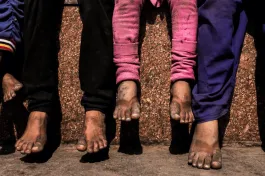At Independence, India inherited a formal but widely disparate modern education system. The decades of colonial rule had restructured a complex and largely exclusionary terrain of indigenous knowledge systems. The ‘modern education’ that came to be organised school curricula around secular subjects such as science, mathematics, history, and geography.
These wide-scale educational arrangements led to a mechanical standardising that valorised textbook-centred forms of teaching-learning processes. Forms of indigenous learning rooted in communities’ socio-cultural practices were excluded – except perhaps some religious precepts that found new homes as ‘moral education’. Education was narrowly aligned with securing a government job in the emerging colonial economy.
The Nehruvian state built upon existing colonial infrastructure to chart a new pathway for the nation, where formalised basic sciences and technical knowledge would centre academic learning and, in turn, foster new ideas of progress and development. Running counter to this mainstream vision were ideas traced back to Gandhi and Tagore, who stressed the need to reorient the alienating nature of the colonial modern education system.
Thinkers of the latter persuasion felt that this format of modern education would continue to alienate a large segment of the country’s population – especially people engaged in farming and other associated vocations that involved hard manual labour. They argued that overemphasising academic learning would reinforce the existing pedagogical regime of rote-based learning. Worse, it would perpetuate the hierarchy of professional aspirations, where those who worked with their ‘minds’ would be seen as superior to those who worked with their ‘hands’.
Nehruvian ideas on education were regnant, set as they were within the larger development project of the age. Alternative views, like Gandhi’s Nai Talim scheme for basic education, were seen as unpragmatic.
In the immediate years after independence, Nehruvian ideas on education were regnant, set as they were within the larger development project of the age. Alternative views, like Gandhi’s Nai Talim scheme for basic education, were seen as unpragmatic. There were also more persuasive critiques. While both Gandhi and Tagore called for the need to break the ‘manual labour’ and ‘intellectual labour’ divide in education that the colonial education system had reinforced in new ways, their silence on the oppressive entrenchment of caste and associated land-labour arrangements in the rural landscape made some of their positive education initiatives seem superficial and in turn ineffectual in changing the dynamics of inequity. Even some Congress nationalists were uncomfortable with Gandhi’s scheme as it spoke of young rural children making local artefacts and selling them to cover the costs of their teachers’ salaries (Holzwarth 2015).
The experimental decades
It is pertinent to note that into the 1970s, formal school education was abysmally ignored across the country. This was a consequence of an education policy regime that was fragmented between the centre and the states and of poor state investment. The cracking of the Nehruvian consensus in the late 1960s and the 1970s – and with it, growing anti-centre sentiments and despair at continued mass illiteracy and poverty – contributed to the growth of vibrant civil society spaces where the ‘discarded’ ideas could find fresh air.
Within this larger social and political landscape came about a set of alternative education institutions, which drew from Gandhi and Tagore but also from international discourses on learner-centred pedagogies. The institutions that chose to follow this alternative pathway moved away from textbook-centred learning, bringing into the curriculum an array of arts, crafts, languages and pedagogical cultures rooted within the everyday labour and lives of rural and indigenous communities.
The founders of alternative institutions visualised education as breaking the hierarchy of academic learning over manual work. But serious concerns remained. The most pressing issue was integration with existing formal education systems.
In a deeply caste-ridden and ethnically diverse society such as India, those who picked up the threads from Gandhi’s and Tagore’s visions for indigenising the curriculum did not necessarily discard modern epistemological principles. Instead, they sought to conceptualise alternative education routes which foregrounded varied knowledge systems and pedagogies that helped learners connect with their lived experiences, build curiosity, and aid in the flourishing of their inner selves.
These experiences of indigenising curriculum and modes of teaching-learning were mixed. The founders of alternative institutions visualised education as breaking the hierarchy of academic learning over manual work. But serious concerns remained. The most pressing issue was integration with existing formal education systems. Aspects of upward educational and professional mobilities remained peripheral or non-existent within this broad alternative education framework.
Janaki Nair’s edited Un/Common Schooling: Educational Experiments in Twentieth Century India traces the trajectories and challenges of alternative education beyond the yardsticks of triumphs or failures. Several of the educators who set up institutions in the 1970s and 1980s reflect on the circumstances that paved their journeys into alternative education in post-independence India: K.T. Margaret (Tilak Nagar Children’s Centre in Bengaluru), Jane Sahi (The Sita School in Silvepura, Karnataka), Rashmi Paliwal (Eklavya in Madhya Pradesh), Malathi M.C. (Vikasana in Doddakallsandra, Karnataka), and Shirly Joseph (Kanavu in Wayanad, Kerala). In these schools, they taught children in small multi-grade groups, drawing on languages that the children were familiar with, and introduced a range of unstructured activities that motivated children to explore their local environments and learn language, maths, social studies, and science in innovative ways. The core philosophy in these alternative schools was to emphasise cooperation and not competition.
The narratives are evocative, grounding the need to provide care and a safe, encouraging environment for first-generation learners. Most founders outline the skills and care these young children received at their institutions, allowing them to transition into the more disciplined and regimented routine of formal schools. However, we have little insight into what it takes to run an alternative education institution sustainably. There is a brief mention of private funding, including corporate donations, but otherwise, there is hardly any engagement with what it means to function as a non-state institution or the kind of expectations funders had. This is particularly important today as corporate philanthropic interventions in education no longer provide funding without clearly outlined goals on measurable learning outcomes (Srivastava 2020).
What remains stark and unsettling are the recollections of humiliation and violence these marginalised students faced.
As Nair reminds us, none of the institutions featured in this volume exist anymore. Eklvaya, the only one which has remained standing, operates in a very different form and provides after-school support to students enrolled in formal schools in Madhya Pradesh. Paliwal’s chapter situates the challenges faced by Eklavya in scaling up its innovative curriculum and teaching practices within the state government school system in Madhya Pradesh. In a country mired with abysmal infrastructural resources and a poor pedagogical environment for teaching elementary school science, Eklavya was at the forefront of getting students to experience science through processes of observation and conducting experiments. (This work significantly influenced the curriculum of innovative education programmes at Delhi University, Tata Institute of Social Sciences, and Azim Premji University. Members of Eklavya were also a part of the National Curricular Framework committees through the 2000s. Their influence can be seen in the maths, language, science, and social science textbooks.) That this programme had to be wound down is telling of the crippling impact when the state government (or, more broadly, a major stakeholder) backs out of its commitments.
What did school education – formal, mainstream, or alternative – mean to students from marginalised backgrounds, often first-generation learners? A set of essays in this book draws on oral histories to understand their experience and how it has shaped their perspectives of learning. What remains stark and unsettling are the recollections of humiliation and violence these marginalised students faced, the absence of ‘social and cultural capital networks’ to guide them in their education choices, and having to enter the workforce much earlier than their privileged counterparts.
We read of young lower-middle-class women studying at a vocational education institution (Industrial Training Institute) in Noida, memories of schooling in diverse schools across Uttar Pradesh and Madhya Pradesh, the role of the family and the politics of persisting within a system that concertedly works against first generation learners. Alongside these narratives of struggle, Janaki Nair’s discussion also juxtaposes some schooling experiences of a few well-known Dalit intellectuals from Karnataka by examining their rich autobiographies.
The thoughtful reflections of Jane Sahi engage with the nagging question of marginalised students’ pragmatic concerns and aspirations for structure, vocational skills, notably English language skills, and other associated credentials.
In an essay that offers cautious hope, K.N. Sunandan outlines the powerful role of care and kindness in the pastoral relationships between teachers and marginalised students in Kerala. He makes a critical distinction between patronising benevolence and for teachers to understand the politics of care. The latter can encourage students to continue persevering, especially when deep-seated structural inequities force them to drop out of the system. Sunandan also provides a larger backdrop of the decentralisation and education reforms in Kerala in the 1990s to situate some pertinent shifts in participation and decision-making at the local levels. However, these changes do not necessarily translate to more equitable participation by lower-caste members in governance processes.
The limits of alternatives
While the lack of rigid state regulations allowed for certain pedagogical and curricular freedoms, there remained a certain ambiguity within the broader objectives at the alternative institutions, especially in the context of higher education mobility and associated entry into a formal job market.
The thoughtful reflections of Jane Sahi engage with the nagging question of marginalised students’ pragmatic concerns and aspirations for structure, vocational skills – notably English language skills – and other associated credentials. By the 1980s, most parents of students at her Sita School were keen to send their wards to the local ‘convent school’, as it provided English medium education.
This was a sign of things to come. Through the 1990s and 2000s, school education received new attention with international aid organisations’ funding education schemes across the country and significant legal shifts that led to the passage of the Right to Free and Compulsory Education Act, 2009 (Kamat 2012). These changes occurred within a new political economy where the state withdrew from welfare responsibilities to take on a purely regulatory role. In parallel, the private sector opened up a host of new professional opportunities.
What emerged was a landscape of institutions signalling the new utilitarian nature of education, skills, and the job market. They included private coaching centres (addressing a range of entrance examinations across disciplines and a variegated government job market), low-cost private schools (offering a range of fee structures) and English language training classes (to access various kinds of opportunities in the precarious retail economy sector).
This emergent situation needs to be unpacked and engaged with to understand the social, affective and new economic aspirations of the poor. The complexity of the multiple meanings imbued in education and the desires that marginalised families harbour for the upward social and economic mobility of their children upend the comfortable binary between alternative education as ‘joyful learning with no stress of assessments’ versus formal education as ‘regimented and solely for credentials’.
Vidya Subramanian is an associate professor at the Jindal School of Government and Policy, OP Jindal Global University, Sonipat.









